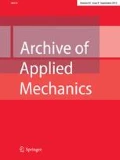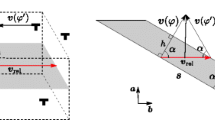Abstract
Continuum dislocation theory (CDT) allows the consideration of dislocation ensembles by introducing the dislocation density tensor. Though the kinematics of geometrically linear CDT are well established, the closure of governing field equations is not finished yet. The present study now brings together different principles for such a closure: It is shown how the field equations for the CDT can be obtained from potential energy minimization and from the phase field approach. These two energetic methods are integrated into a generic thermodynamic framework with twofold benefit: First, the rigorous thermodynamic treatment allows clarifying physical consequences of the energetic methods, among them the proof of thermodynamic consistency. Second, the framework provides a basis for consistent extensions of CDT. In this way, a new dynamic formulation of CDT is presented, which enables the analysis of the evolution of dislocation structures during plastic deformation. Moreover, a variety of possible dissipative phenomena is considered and the mechanical balance laws are deduced. For two special cases, the field equations are derived in the strong form and the stability of the solution is analyzed. Next, a flexible numerical solution algorithm is presented using the finite difference method. Solutions of various initial boundary value problems are presented for the case of plane deformations. Therefore, some of the dissipative phenomena are further investigated and two distinct sources of the Bauschinger effect are identified. Special attention is also given to different boundary conditions and their effect on the solution. For the case of uniaxial compression, the numerical results are confronted with experimental data. Thus, the simulations are validated and a new consistent interpretation of the experimental results is achieved.
Similar content being viewed by others
References
Agiasofitou, E., Lazar, M.: On the nonlinear continuum theory of dislocations: a gauge field theoretical approach. J. Elast. 99(2), 163–178 (2010)
Amodeo, R.J., Ghoniem, N.M.: Dislocation dynamics. ii. Applications to the formation of persistent slip bands, planar arrays, and dislocation cells. Phys. Rev. B 41, 6968–6976 (1990)
Arsenlis, A., Parks, D.M.: Crystallographic aspects of geometrically-necessary and statistically-stored dislocation density. Acta Mater. 47(5), 1597–1611 (1999)
Berdichevsky, V.: Continuum theory of dislocations revisited. Contin. Mech. Thermodyn. 18(3–4), 195–222 (2006)
Berdichevsky, V.L.: On thermodynamics of crystal plasticity. Scripta Mater. 54(5), 711–716 (2006)
Berdichevsky, V.L., Le, K.C.: Dislocation nucleation and work hardening in anti-plane constrained shear. Contin. Mech. Thermodyn. 18(7–8), 455–467 (2007)
Biot, M.A.: Theory of propagation of elastic waves in a fluidsaturated porous solid. i. Lowfrequency range. J Acoust. Soc. Am. 28(2), 168–178 (1956)
Bulatov, V., Cai, W.: Computer Simulations of Dislocations (Oxford Series on Materials Modelling). Oxford University Press, Oxford (2006)
Chiu, Y., Veyssiere, P.: Dislocation self-organization under single slip straining and dipole properties. Mater. Sci. Eng. A 483–484, 191–194 (2008)
Cleja-Tigoiu, S.: Non-local elasto-viscoplastic models with dislocations in finite elasto-plasticity. Part i: constitutive framework. Math. Mech. Solids 18(4), 349–372 (2013)
Cordero, N.M., Gaubert, A., Forest, S., Busso, E.P., Gallerneau, F., Kruch, S.: Size effects in generalised continuum crystal plasticity for two-phase laminates. J. Mech. Phys. Solids 58(11), 1963–1994 (2010)
Dj, S., Forest, S., Jaric, J.P.: Size-dependent energy in crystal plasticity and continuum dislocation models. Proc. R. Soc. A 471(2175), 20140,868+ (2015)
Field, D.P., Magid, K.R., Mastorakos, I.N., Florando, J.N., Lassila, D.H., Morris, J.W.: Mesoscale strain measurement in deformed crystals: a comparison of x-ray microdiffraction with electron backscatter diffraction. Phil. Mag. 90(11), 1451–1464 (2010)
Florando, J.N., LeBlanc, M.M., Lassila, D.H.: Multiple slip in copper single crystals deformed in compression under uniaxial stress. Scr. Mater. 57(6), 537–540 (2007)
Forest, S., Guéninchault, N.: Inspection of free energy functions in gradient crystal plasticity. Acta. Mech. Sin. 29(6), 763–772 (2013)
Giorgi, C.: Continuum thermodynamics and phase-field models. Milan J. Math. 77(1), 67–100 (2009)
Gregor, V.: Self-organization approach to cyclic microplasticity: a model of a persistent slip band. Int. J. Plast. 14(1–3), 159–172 (1998)
Groma, I., Csikor, F.F., Zaiser, M.: Spatial correlations and higher-order gradient terms in a continuum description of dislocation dynamics. Acta Mater. 51(5), 1271–1281 (2003)
Groma, I., Vandrus, Z., Ispanovity, P.D.: Scale-free phase field theory of dislocations. Phys. Rev. Lett. 114(1), 015503 (2015)
Gurtin, M.E.: A gradient theory of single-crystal viscoplasticity that accounts for geometrically necessary dislocations. J. Mech. Phys. Solids 50(1), 5–32 (2002)
Gurtin, M.E., Anand, L.: A theory of strain-gradient plasticity for isotropic, plastically irrotational materials. Part ii: finite deformations. Int. J. Plast. 21(12), 2297–2318 (2005)
Hochrainer, T.: Thermodynamically consistent continuum dislocation dynamics. J. Mech. Phys. Solids 88, 12–22 (2016)
Hull, D., Bacon, D.J.: Introduction to Dislocations, 5th edn. Butterworth-Heinemann, Oxford (2011)
Javanbakht, M., Levitas, V.I.: Phase field approach to dislocation evolution at large strains: computational aspects. Int. J. Solids Struct. 82, 95–110 (2016)
Kaluza, M., Le, K.C.: On torsion of a single crystal rod. Int. J. Plast. 27(3), 460–469 (2011)
Kochmann, D.M., Le, K.C.: Dislocation pile-ups in bicrystals within continuum dislocation theory. Int. J. Plast. 24(11), 2125–2147 (2008)
Kossevich, A.M.: The Crystal Lattice. Wiley-VCH Verlag GmbH & Co. KGaA, Weinheim (1999)
Koster, M., Le, K.C., Nguyen, B.D.: Formation of grain boundaries in ductile single crystals at finite plastic deformations. Int. J. Plast. 69, 134–151 (2015)
Koyama, T.: Phase field. In: Czichos, H., Saito, T., Smith, L. (eds.) Springer Handbook of Materials Measurement Methods, pp. 1031–1055. Springer, Berlin (2006)
Kröner, E.: The internal mechanical state of solids with defects. Int. J. Solids Struct. 29(14–15), 1849–1857 (1992)
Kysar, J.W., Saito, Y., Oztop, M.S., Lee, D., Huh, W.T.: Experimental lower bounds on geometrically necessary dislocation density. Int. J. Plast. 26(8), 1097–1123 (2010)
Lazar, M., Anastassiadis, C.: The gauge theory of dislocations: static solutions of screw and edge dislocations. Phil. Mag. 89(3), 199–231 (2009)
Le, K.C.: Introduction to Micromechanics. Nova Science, Hauppauge (2010)
Le, K.C.: Three-dimensional continuum dislocation theory. Int. J. Plast. 76, 213–230 (2016)
Le, K.C., Günther, C.: Nonlinear continuum dislocation theory revisited. Int. J. Plast. 53, 164–178 (2014)
Le, K.C., Nguyen, B.D.: Polygonization: theory and comparison with experiments. Int. J. Eng. Sci. 59, 211–218 (2012)
Le, K.C., Nguyen, Q.S.: Polygonization as low energy dislocation structure. Contin. Mech. Thermodyn. 22(4), 291–298 (2010)
Le, K.C., Sembiring, P.: Analytical solution of plane constrained shear problem for single crystals within continuum dislocation theory. Arch. Appl. Mech. 78(8), 587–597 (2008)
Le, K.C., Sembiring, P.: Plane constrained shear of single crystal strip with two active slip systems. J. Mech. Phys. Solids 56(8), 2541–2554 (2008)
Le, K.C., Sembiring, P.: Plane constrained uniaxial extension of a single crystal strip. Int. J. Plast. 25(10), 1950–1969 (2009)
Levitas, V.I., Javanbakht, M.: Thermodynamically consistent phase field approach to dislocation evolution at small and large strains. J. Mech. Phys. Solids 82, 345–366 (2015)
Magid, K.R., Florando, J.N., Lassila, D.H., LeBlanc, M.M., Tamura, N., Morris, J.W.: Mapping mesoscale heterogeneity in the plastic deformation of a copper single crystal. Phil. Mag. 89(1), 77–107 (2009)
Negahban, M.: Vectors and Tensors, pp. 117–167. CRC Press, Boca Raton (2012)
Ottosen, N.S., Ristinmaa, M.: The Mechanics of Constitutive Modeling. Elsevier, Amsterdam (2005)
Pantleon, W.: Resolving the geometrically necessary dislocation content by conventional electron backscattering diffraction. Scr. Mater. 58(11), 994–997 (2008)
Richeton, T., Dobron, P., Chmelik, F., Weiss, J., Louchet, F.: On the critical character of plasticity in metallic single crystals. Mater. Sci. Eng. A 424(1–2), 190–195 (2006)
Sandfeld, S., Monavari, M., Zaiser, M.: From systems of discrete dislocations to a continuous field description: stresses and averaging aspects. Modell. Simul. Mater. Sci. Eng. 21(8), 085,006+ (2013)
Sandfeld, S., Thawinan, E., Wieners, C.: A link between microstructure evolution and macroscopic response in elasto-plasticity: formulation and numerical approximation of the higher-dimensional continuum dislocation dynamics theory. Int. J. Plast. 72, 1–20 (2015)
Shutov, A.V., Ihlemann, J.: A viscoplasticity model with an enhanced control of the yield surface distortion. Int. J. Plast. 39, 152–167 (2012)
Shutov, A.V., Kreißig, R.: Finite strain viscoplasticity with nonlinear kinematic hardening: phenomenological modeling and time integration. Comput. Methods Appl. Mech. Eng. 197(21–24), 2015–2029 (2008)
Silbermann, C.B., Ihlemann, J.: Kinematic assumptions and their consequences on the structure of field equations in continuum dislocation theory. IOP Conf. Ser. Mater. Sci. Eng. 118, 012,034+ (2016)
Silbermann, C.B., Ihlemann, J.: Analogies between continuum dislocation theory, continuum mechanics and fluid mechanics. IOP Conf. Ser. Mater. Sci. Eng. 181, 012,037+ (2017)
Silbermann, C.B., Shutov, A.V., Ihlemann, J.: Modeling the evolution of dislocation populations under non-proportional loading. Int. J. Plast. 55, 58–79 (2014)
Ván, P., Berezovski, A., Papenfuss, C.: Thermodynamic approach to generalized continua. Contin. Mech. Thermodyn. 26(3), 403–420 (2014)
Walgraef, D.: Spatio-Temporal Pattern Formation. Springer, New York (1997)
Wang, Y.U., Jin, Y.M., Cuitiño, A.M., Khachaturyan, A.G.: Nanoscale phase field microelasticity theory of dislocations: model and 3d simulations. Acta Mater. 49(10), 1847–1857 (2001)
Wriggers, P.: Solution methods for time independent problems. In: Nonlinear Finite Element Methods, pp. 149–204. Springer Heidelberg (2008)
Wulfinghoff, S., Forest, S., Böhlke, T.: Strain gradient plasticity modeling of the cyclic behavior of laminate microstructures. J. Mech. Phys. Solids 79, 1–20 (2015)
Xia, S., El-Azab, A.: Computational modelling of mesoscale dislocation patterning and plastic deformation of single crystals. Modell. Simul. Mater. Sci. Eng. 23(5), 055,009+ (2015)
Zahn, D., Tlatlik, H., Raabe, D.: Modeling of dislocation patterns of small- and high-angle grain boundaries in aluminum. Comput. Mater. Sci. 46(2), 293–296 (2009)
Author information
Authors and Affiliations
Corresponding author
Electronic supplementary material
Below is the link to the electronic supplementary material.

Supplementary material 1 (gif 9147 KB)
Plastic slip field \(\beta_p/ \permille \) for \(\varphi=0^\circ\), final state plotted on the deformed crystal domain (magnified by a factor of 20): the fields are inhomogeneous.

Supplementary material 2 (gif 6942 KB)
Plastic slip field \(\beta_p/ \permille\) for \(\varphi=45^\circ\), final state plotted on the deformed crystal domain (magnified by a factor of 20): the fields are inhomogeneous.

Supplementary material 3 (gif 9830 KB)
Dislocation density field \(\rho_d/ {\upmu m}^{-2} {\rm for} \varphi=0^\circ\), final state plotted on the undeformed crystal domain: dislocation structures with a high density have emerged.

Supplementary material 4 (gif 6787 KB)
Dislocation density field \(\rho_d/ {\upmu m}^{-2} {\rm for} \varphi=45^\circ\), final state plotted on the undeformed crystal domain: dislocation structures with a high density have emerged.
Rights and permissions
About this article
Cite this article
Silbermann, C.B., Ihlemann, J. Geometrically linear continuum theory of dislocations revisited from a thermodynamical perspective. Arch Appl Mech 88, 141–173 (2018). https://doi.org/10.1007/s00419-017-1296-z
Received:
Accepted:
Published:
Issue Date:
DOI: https://doi.org/10.1007/s00419-017-1296-z




